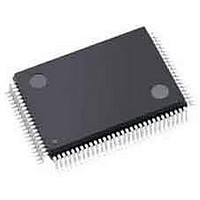ISPPAC-CLK5510V-01T48C Lattice, ISPPAC-CLK5510V-01T48C Datasheet - Page 23

ISPPAC-CLK5510V-01T48C
Manufacturer Part Number
ISPPAC-CLK5510V-01T48C
Description
Clock Drivers & Distribution PROGRAMMABLE CLOCK GENERATOR
Manufacturer
Lattice
Datasheet
1.PAC-SYSTEMCLK5520.pdf
(48 pages)
Specifications of ISPPAC-CLK5510V-01T48C
Minimum Operating Temperature
0 C
Mounting Style
SMD/SMT
Maximum Operating Temperature
70 C
Package / Case
TQFP-100
Lead Free Status / RoHS Status
Lead free / RoHS Compliant
Available stocks
Company
Part Number
Manufacturer
Quantity
Price
Company:
Part Number:
ISPPAC-CLK5510V-01T48C
Manufacturer:
Lattice Semiconductor Corporation
Quantity:
10 000
Lattice Semiconductor
Differential HSTL and SSTL
HSTL and SSTL are sometimes used in a differential form, especially for distributing clocks in high-speed memory
systems. Figure 19 shows how ispClock5500 reference input should be configured for accepting these standards.
The major difference between the differential and single-ended forms of these logic standards is that in the differen-
tial cases, the REFA- input is used as a signal input, not a reference level, and that both terminating resistors are
engaged and set to 50Ω.
Figure 19. Differential HSTL/SSTL Receiver Configuration
LVDS/Differential LVPECL
The receiver should be set to LVDS or LVPECL mode as required and both termination resistors should be
engaged and set to 50Ω. The REFVTT pin, however, should be left unconnected. This creates a floating 100Ω dif-
ferential termination resistance across the input terminals. The LVDS termination configuration is shown in
Figure 20.
Figure 20. LVDS Input Receiver Configuration
Driver
LVDS
VTT
+Signal In
-Signal In
REFVTT
REFA+
REFA-
-Signal In
+Signal In
ispClock5500
50
CLOSED
No Connect
REFVTT
50
REFA+
REFA-
23
CLOSED
ispClock5500
50
Differential
Receiver
CLOSED
ispClock5500 Family Data Sheet
50
CLOSED
Differential
Receiver











